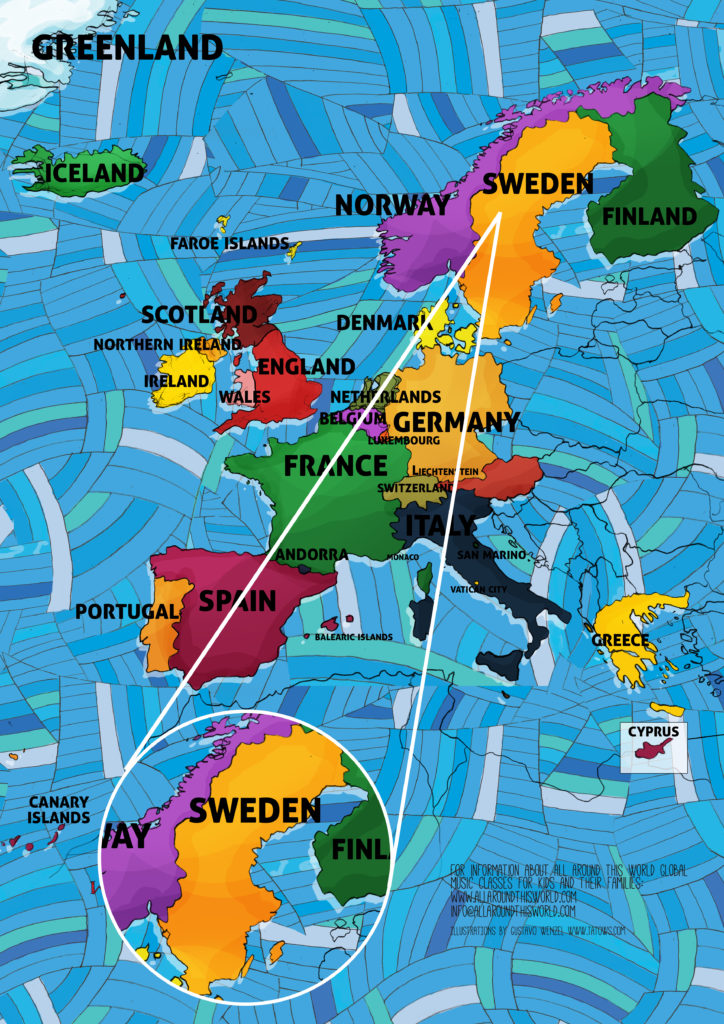We end our week of Swedish music and celebrations with some misdummer madness. On the longest day of the year, the summer solstice, Swedes circle a maypole, search the forests for flowers and leap seven times, superstitiously, over fences. By far the best thing they do to celebrate the holiday is dance around a field like frogs. The Swedish frog song you’ll see in this video is “Små grodorna”: “Små grodorna, små grodorna är lustiga att se…The little frogs, the little frogs are funny to observe. No ears, no ears, no tails do they possess. Kou ack ack ack, kou ack ack ack, kou ack ack ack ack kaa.” The celebrating Swedes hold hands around a circle, simulate the eyelss and tailless frogs — not factual — and then hop hop hop. Any Swede, they’ll tell you — “Små grodorna” = midsummer.
Tag Archives | Sweden
Sweden’s Longest Day
In the middle of the summer far up north in Scandinavia the days grow longer and longer and people get ready for a party. Known in Sweden as ‘Midsommar,” this mid-summer holiday, celebrated some time between June 19th and 24th, marks the days of the year with the most daylight, the pagan celebration of the coming of summer and, not insignificantly, the beginning of the school vacation. Swedish Midsummer celebrations include dances around a maypole (a “midsommarstång,” or “midsommar pole”) wrapped in greens. Also, Swedish tradition dictates that on the eve of midsummer unmarried girls pick seven kinds of flowers, jump over seven roundpole fences, then put the flowers under their pillows while they sleep. That way they’ll dream about their future spouse.
Oh, and to celebrate Midsummer Swedes dance like frogs. We’ll do that tomorrow.
Bubblegum Dance will make you SMILE
Scandinavia is undoubtedly, and presumably proudly, the global capital of a musical genre called “bubblegum dance.” What is bubblegum dance? Take Eurodance, remove all its dark, brooding chord patterns and its deeply profound lyrics–okay, there are none–put a smiley, bouncing polish on the package and you’ll be pretty close to figuring it out. According to Bubblegumdancer.com, “Your number one guide to the world’s happiest music,” bubblegum dance music, which typically consists of upbeat, high-pitched female vocals and a male singing or rapping in low, quiet tones, “is often playful and child-like. Common singing topics include fantasy characters such as wizards and princesses, and songs about having fun, love, partying, and eating candy.” In this video we watch our favorite bubblegum dance group, Smile.Dk, search nonsensically for samurais in “Butterfly.”
We Need the Nyckelharpa
The most distinct ancient Swedish folk instrument, often used to accompany the Swedish dance known as “polska,” is the nyckelharpa, a “keyed fiddle” that musicians play with a bow. In this video we enjoy a performance of Spelmansglädje on the ancient instrument by Edward Anderzon and Elin Skoglund, two nyckelharping Swedes.
ABBA — Of COURSE.
When we learn about the music of Sweden in class we simply must go there, and right away — ABBA!
ABBA! ABBA! ABBA! ABBA!
Sweden’s ABBA is one of the best selling bands of all time. Ever. In the whole universe. Formed in Stockholm, Sweden, in the early ’70s, ABBA (composed of two married Swedish couples who used the first letters of their names to compose the name of their group) rocketed to international stardom after their song “Waterloo”–oh my goodness, look at those shoes…!–won the 1974 Eurovision contest. They followed up with an extraordinary string of hits like “SOS,” “Mamma Mia,” “Fernando,” “Take a Chance on Me,” and, of course, “Dancing Queen.” ABBA’s two marriages broke up in 1979 and 1981 and, much to the world’s chagrin, the band broke up in 1983, though they have continued to sell millions of albums a year.
Stunning Sweden and Fantastic Finland
This week we continue our jaunt up north with a musical visit to Sweden, which shares much language and culture with the other Scandinavian nations–Denmark and Norway. In particular, Swedish folk music has a lot in common with the folk of its Scandinavian neighbors–fiddles, accordions, clarinets and a whole lot of dancing. In the same fell swoop in our online class (not necessarily in our blog posts, but we’ll see) we’re also going to visit Finland, Sweden’s non-Scandinavian neighbor to the east. We really shouldn’t swoop the two together — they’re different in most every way, from history to language to most elements of their culture. But, swoop we shall.
To a great week!
The Future of Music is Now
In our online classes we’ve spent the last three months “Connecting the Dots,” traveling in musical terms all around the world, celebrating the international fusion of cultures everywhere…and the new day has just begun. This five year-old rapper from Sweden will never know a time when he can’t instantaneously access almost the entirety of the world’s music in the super-computer in the palm of his hands. We can’t begin to fathom the where the seamless and inextricable intertwining of everything will take us — not just musically, and culturally, but beyond. Rap on, little Swedish boy! The future is now.
Next week we take a break from our heady international travels, sing a few of our favorites and get a’ready the spend the next three months to brave a whole new season.
Jazz in the Northernmost North
Jazz may have been born in steamy New Orleans, but musicians around the world find a way to sizzle no matter where they live. For example, jazz is widely popular in Scandinavia, where our northernmost performers may not necessarily be funky but they certainly can be fabulous. In this video the too-soon-departed pianist Esbjörn Svensson makes the case for jazzy Swedes.


